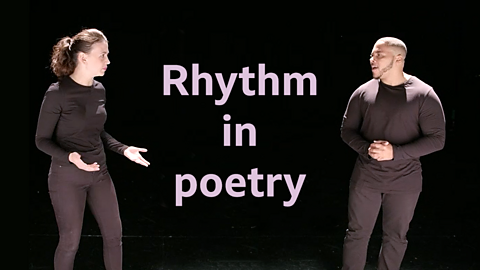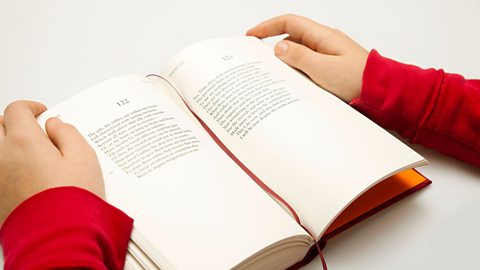What do you know?
How many sonnets did Shakespeare write?
A. 64
B. 14
C. 154
C. 154.
Throughout his career, Shakespeare wrote a total of 154 sonnets. They were all published together in a book in 1609. He also wrote six additional sonnets which appear in three of his plays т Romeo and Juliet, Henry V and Loveтs Labourтs Lost.
Introduction to sonnets
Key learning points
- The traditional conventions of a sonnet
- How the form of the sonnet has changed over time
- Shakespearean, Petrarchan and modern sonnets
- Traditional features such as iambic pentameter, rhyme and the theme of love
A video about sonnets
Video about the conventions, themes and rhythm of Shakespearean sonnets, Petrarchan sonnets and modern sonnets
Sonnets are a form of poem that was much loved by William Shakespeare.
This one might be his most famous: Sonnet 18. 'Shall I compare thee to a summerтs day?' asks Shakespeare.
A sonnet is usually based on just one idea, so he compares someone to a summerтs day for [with incredulity] the full 14 lines. There is usually a turning point at line eight, called a volta. Here the poem usually shifts mood or focus.
For his sonnets, Shakespeare used a strict rhyme scheme of three rhyming stanzas of four lines, known as quatrains, and then one rhyming stanza of two lines, known as a couplet.
The quatrains use this rhyme scheme: ABAB CDCD EFEF followed by the couplet: GG.
And Shakespeare used this form for every single one of his 154 sonnets!
But Shakespeareтs sonnets are not the only kind. Other sonnet forms include the Petrarchan sonnet, which uses a slightly different rhyme scheme, though still uses 14 lines. Modern sonnets follow the same basic conventions, including the pattern: da-DUM, da-DUM, da-DUM, da-DUM, da-DUM.
This pattern is known as iambic pentameter, but it just means that each line has five da-DUMs and the stress is always on the second syllable. It sounds like a beating heart, perhaps it works well for the common theme of love?
It mirrors the patterns of everyday talk, which means the words can really flow.
Whatever the weather.
General conventions of a sonnet
The poetic form of the sonnet originated in the 13th century in Italy. It was originally intended as a way of expressing romantic love among the upper classes.
Traditional sonnets follow a set of rules. The most common rules are:
- A 14 line structure
- It has a regular rhyme schemeA repeated pattern of rhymes, usually written with letters ABAB would mean lines 1 and 3 rhyme; and lines 2 and 4 rhyme also rhyme but differently.
- It follows a regular rhythmRhythm can be described as the beat and pace of a poem. Rhythm is created by the pattern of stressed and unstressed syllables in a line or verse. (also called the metre)
What is a rhyme scheme?
A rhyme scheme means the pattern of the rhyming words at the end of each line. For example, look at the pattern of rhymes in the first section of this Shakespearean sonnet:
Shall I compare thee to a summerтs day? A
Thou art more lovely and more temperate. B
Rough winds do shake the darling buds of May, A
And summerтs lease hath all too short a date. B
The words тdayт and тMayт rhyme so they are both given the letter тAт. Then тtemperateт and тdateт rhyme so they are both given the letter тBт (the words temperate would have been pronounced to rhyme with date) Therefore, this section of the sonnet has a rhyme scheme of ABAB.
If a new rhyme is used, then the next letter in the alphabet continues the pattern.
A video of Shakespeare's Sonnet 18
A video of Shakespeare's Sonnet 18
Shall I compare thee to a summerтs day?
Thou art more lovely and more temperate:
Rough winds do shake the darling buds of May,
And summerтs lease hath all too short a date;
Sometime too hot the eye of heaven shines,
And often is his gold complexion dimmтd;
And every fair from fair sometime declines,
By chance or natureтs changing course untrimmтd;
But thy eternal summer shall not fade,
Nor lose possession of that fair thou owтst;
Nor shall death brag thou wanderтst in his shade,
When in eternal lines to time thou growтst:
Т Т Т So long as men can breathe or eyes can see,
Т Т Т So long lives this, and this gives life to thee.
What is a regular rhythm?
In poetry, rhythm is the beat and pace of a line of poetry. A regular rhythm has a regular beat to each line of the poem. Sonnets typically have ten beats in a line т this is called an iambic pentameter.
Shakespearean sonnets end in two lines that rhyme with one another, called a couplet.
Shakespearean sonnets
Shakespeareтs sonnets are some of the most well-known in the English language. In total, Shakespeare wrote a large number of sonnets so it is unsurprising that he made a few changes to the traditional structure and themes associated with this form.
Shakespeare kept the 14 line structure and followed a regular rhyme scheme. His sonnets usually change the rhyming pattern every four lines т so that each sonnet is made up of three quatrainA stanza of a poem made up of four lines.. Shakespeareтs sonnets usually end with a rhyming couplet. A traditional Shakespearean sonnet has a rhyme scheme of ABAB CDCD EFEF GG.
Instead of writing a series of love poems to a goddess-like female, as previous poets had done, Shakespeareтs sonnets express feelings of lust, mortality, infidelity and jealousy towards one of two characters. Some of his sonnets were written for a young man (the тFair Youthт) whilst others appear to address a тDark Ladyт.
Petrarchan sonnets
The word sonnet derives from the Italian word sonetto which means тlittle soundт or тlittle songт. Petrarchan sonnets are also known as Italian sonnets, and are named after an Italian poet named Francesco Petrarca, who lived in the 14th century. The structure and form of this type of sonnet was developed by various RenaissanceA period in European history from 1300-1600 which saw new scientific discoveries and the creation of great art. poets.
Petrarchan sonnets all have 14 lines, however they are usually split into two sections: an octaveA rhyming section of a poem with eight lines. followed by a sestetA rhyming section of a poem with six lines..
The rhyme schemes for the octave usually follow an ABBAABBA pattern and the sestet can vary between CDECDE or CDCDCD.
The octave usually introduces the reader to a problem or conflict and the sestet then provides the solution. The change that occurs between the octave and sestet is called a volta. Volta means тturnт in Italian.
Modern sonnets
Many modern poets have written sonnets which do not follow the exact structure or rhyme scheme of the Petrarchan or Shakespearean sonnets. Poets often enjoy playing around with this poetic form.
Some poets have chosen not to use rhyme in their sonnet. In the 1920s, WH Auden wrote one of the first unrhymed sonnets in English, The Secret Agent.
Other poets have written тinvertedт sonnets where the sestet comes first followed by the octave. Sometimes a modern poet may take features from the Shakespearean form and combine them with some of the features from the Petrarchan form.
A feature of modern poetry is that the poet doesnтt have to use тend stoppedт lines. Instead the poet can use тrun on linesт (or enjambment). The Trick by Imtiaz Dharker is an example of a modern sonnet that uses some тrun on linesт.
Sometimes the only way to spot a modern sonnet is that it has 14 lines!
Common rules of a sonnet
Iambic pentameter
This is a rhythm of unstressed syllable followed by a stressed syllable, with a total of 10 beats. A good way to think about iambic pentameter is to think about the sound of a heartbeat (duh-DUM, duh-DUM, duh-DUM). If we take a word like тdelightт, we pronounce it тde-lightт where we place more emphasis on the second syllable.
Rhyme
Petrarchan sonnets tend to follow a rhyme scheme of ABBAABBA CDCDCD or ABBAABBA CDECDE whereas Shakespearean sonnets follow a rhyme scheme of ABAB CDCD EFEF GG. The rhyme pattern often identifies sections of meaning in the poem. These sections have names that tell us how many lines they have:
- Couplet т two lines
- Quatrain т four lines
- Sestet т six lines
- Octave т eight lines
Themes
Traditionally, sonnets were written as a form of expression of a personтs romantic love for another. However, some poets have adapted the sonnet to suit a range of other themes. In the case of Rupert Brookeтs The Soldier, the theme of love has remained but instead his sonnet being about his love for a person, it is about his love for his country.

Have a go at writing your own sonnet.
Remember to include the following features:
- Fourteen lines
- Iambic pentameter
- Theme of love
- Split your sonnet into an octave and sestet or three quatrains and a couplet
- Choose the rhyme scheme that matches your structure (ABBAABBA CDCDCD/ ABBAABBA CDECDE/ ABAB CDCD EFEF GG)
- Use a volta
Test your knowledge
Play Bitesize secondary games. gamePlay Bitesize secondary games
Have fun playing science, maths, history, geography and language games.

More on Reading poetry
Find out more by working through a topic
- count6 of 8

- count8 of 8

- count1 of 8
